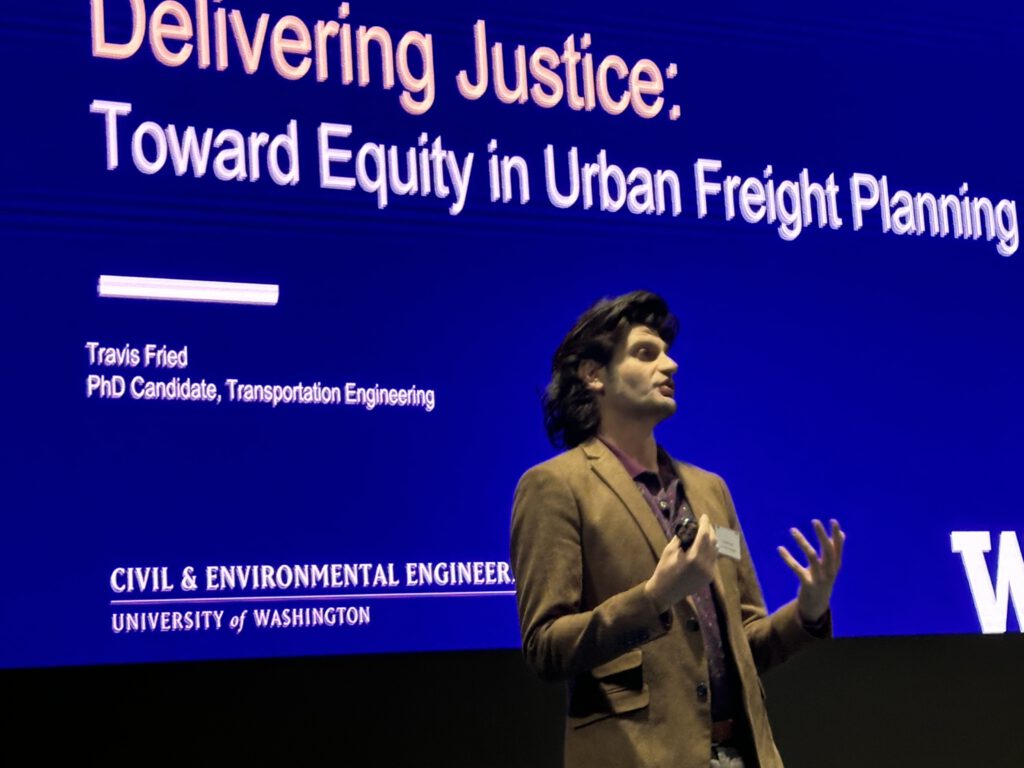As e-commerce continues to grow and expand across, more and more companies are looking towards building their “last-mile” distribution facilities closer to cities enabling next and same-day deliveries for companies like Amazon. What do equity and social justice mean for urban (freight) planning and management?
A new Urban Freight Lab paper reviews transportation and mobility justice theory and finds that urban freight issues are absent from these discussions, primarily concerning passenger and personal mobility. When considering urban freight, the authors discuss emissions, pollution, congestion, noise, and collisions. The paper examines urban freight justice, including access to essential goods, community governance, employment opportunities and barriers, and regional and global perspectives.

Urban freight systems embed and reflect spatial inequities in cities and imbalanced power structures within transport decision-making. These concerns are principal domains of “transportation justice” (TJ) and “mobility justice” (MJ) scholarship that has emerged in the past decade. However, little research exists situating urban freight within these prevailing frameworks, which ill-defined urban freight research on socio-environmental equity and justice, especially compared to passenger or personal mobility discussions. Through the lens that derives from TJ and MJ’s critical dialogue, this study synthesizes urban freight literature’s engagement with equity and justice. The review evaluates:
- How do researchers identify equitable distributions of urban freight’s costs and benefits?
- At what scale do researchers evaluate urban freight inequities?
- And who does research consider entitled to urban freight equity, and how are they involved in urban freight governance?
The findings help inform researchers who seek to reimagine urban freight management strategies within broader equity and justice discourse. Decades-long growth in urbanization and the recent surge in e-commerce have spurred concerns about the uneven impacts of freight’s swelling urban footprint. Transport scholars note increasing conflicts between freight vehicles and vulnerable road users, like bicyclists and pedestrians in dense urban areas. Meanwhile, environmental justice (EJ) scholars have long measured unequal exposure to freight traffic pollution along socio-economic and ethnic lines.
However, relatively few urban freight studies engage with social equity. Those that do usually avoid critical discussions contained in justice-oriented theory, instead portraying the movement of goods as an “apolitical science of circulation.” In the U.S., for instance, apoliticizing urban freight overlooks a history of city industrial zoning practices, infrastructure construction, exclusionary decision-making, and consequent path dependency that placed critical logistics facilities, including highways, manufacturing plants, warehouses, and distribution centers disproportionately near low-income households and non-white, populations of color. The longitudinal effects of these institutional decisions are still largely visible today.
Transportation research also inconsistently defines and measures equity. Arbitrarily engaging with equity concepts, the authors argue, creates normative confusion (e.g., what does an equitable urban freight system look like?) and positive (e.g., what measurable thresholds determine whether an urban freight outcome is inequitable?). Consequently, most equity research measures unequal burdens and benefits distributions but spends less time identifying when and why unequal distributions are unjust. The paper synthesizes prevailing discourse around equity and, by extension, justice in transportation research and urban freight literature.
The paper illuminates several gaps and future directions for urban freight research:
- They are identifying distributive spheres across urban freight that encompass labor quality, environmental justice, and accessibility to goods. In the case of the latter sphere, the paper explores home delivery as a public service that ensures sufficient access to goods for populations with low levels of accessibility. However, research is needed to understand urban freight systems’ specific role in expanding home or near-home-based accessibility and why and how they should be supported beyond the commercial sector.
- Highlighting multi-scalar inequities. The scalar scope for last-mile delivery research is narrow, often impeding the impacts of middle-mile urban freight movement, land use decisions in upstream distribution, and proximity to consolidation facilities. Studies occasionally take a regional perspective on community health impacts but generally fall short in questioning more globalized, green growth assumptions. As a result, stakeholders
often relegate external costs for labor and communities to secondary mitigation tactics compared to port, infrastructure, and warehousing expansion needs. - The authors are observing discrepancies in governance between those entitled to urban freight justice and those considered valid participants in urban freight decision-making. There is little consensus on how cities should democratically engage communities bisected by freight corridors and adjacent to freight-generating land uses. The exclusion of community members, advocates, and workers from the negotiating table necessitates more profound research on “from and for the bottom” freight management strategies and community-based participatory research applications in urban freight research.
- Social and environmental inequities are not apolitical correlations to random external factors nor simply a byproduct of bad actors making purposely discriminatory decisions. Instead, inequities are locked in through historical injustices and globally recirculated by today’s imperfect, often callous political and economic systems. As such, the project of justice – even in as narrow a focus as urban freight – will almost certainly remain a contested ideal and unfinished business. However, serious action toward justice in urban freight requires political reckoning with the field’s assumptions of how benefits, burdens, and even death are distributed down the urban distribution chain and who gets a say.

Thanks Walther for the write up! Great meeting you in Gothenburg!